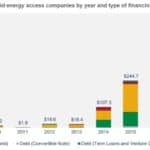It’s Time for More Open Source in Energy Access. Here’s Why.
More private investment. More government support. More mini-grids or less mini-grids. Mesh grids. Combo grids. AgriGrids. Wind turbines, solar lanterns. Radical new ways of financing or more traditional investment. All of these topics (and many more) are frequently discussed, analysed and debated when we try to answer the question: What needs to happen to achieve global access to energy by 2030?
But despite the diversity of options and opinions, at the end of the day, they all mean the same thing: More money needs to be spent in smart and efficient ways.
Part of my job with EnAccess involves talking to energy access innovators, picking their brains on how to best share their ideas. After several years of conversations and interviews, a common viewpoint has emerged: The sector needs an open-source approach to achieve global energy access.
Below, I’ll explain why this model is not only the right thing to do, but is also inevitable — and I’ll discuss why we need to continue to both invest in and promote open-source work, ideas and materials wherever possible.
Reinventing the wheel is a waste of resources
The energy access industry needs new ideas, software, applications, business plans, hardware, and research and development. The pace of innovation moves very quickly in this sector, and effective solutions tend to spread: Whatever brilliant new idea or technology one company is working on is likely also the focus of time and attention from its competitors.
Let’s look at the expansion of the mini-grid model as an example. “Mini-grids show the most potential for inclusivity and impact as they grow,” says this 60 Decibels report, and it’s not an exaggeration to say that the future of global energy access depends on mini-grid companies’ success. It’s also common knowledge that it’s very hard to scale a mini-grid company and become profitable — which means plenty of CEOs, engineers, project managers and developers are working on ideas to help their mini-grid company achieve long-term success and profitably.
ANKA Madagascar was working on just this sort of plan, based on their belief that if they could help increase the wealth of the rural communities they served, it would increase the amount of clean electricity these customers would buy from them. To that end, instead of remaining “just” a mini-grid company, they decided to adopt an AgriGrid business model: Along with providing electricity, they would also play an active role in providing market access for their target communities’ food and agricultural products, boosting their customers’ income and increasing their own revenue generation. EnAccess funded their R&D work to see how feasible this was for ANKA, and we published all of the findings so that any other mini-grid company could learn from — or just copy and adapt — their process.
Instead of keeping their research “closed,” ANKA put themselves out there, inviting others to build on what they had learned. The project created a buzz for the company, and their documentation has been downloaded over 800 times. Someone had to be the first to share their work on this topic, but they don’t have to be the last: Thanks to ANKA’s early contributions, the path is paved for other innovators to create new and improved approaches, without having to completely reinvent the wheel.
Open Source helps create new markets and revenue streams for energy access
One of the reasons this sector has typically needed to develop new models from scratch is because much of the technology we need to provide energy access doesn’t exist yet. This is exciting: Energy access is a sector of innovators, creating services and products that no one could even imagine 10 or 15 years ago — like being able to offer customers in off-grid, rural communities the opportunity to pre-pay for energy services. With each new product or service comes a chance to create an entirely new market around them. For the energy access innovators who break new ground, it’s worth asking this question: What kind of opportunities would open up for you if your service or product were far more popular? The answers to this question illustrate the benefits of an open-source approach.
If the service, idea or product an entrepreneur created were open-source, there would be no barrier for others to adopt, use and even build upon it — thus making their service, idea or product more valuable. With a higher value proposition, they will likely create more buzz around their idea, or sell more of their product, or develop additional products and/or services on top of it. A perfect example of this is the OpenPAYGO Token from Solaris Offgrid — the first of their OpenPAYGO Suite of tools. When I asked Benjamin David, Chief Technology Officer of Solaris Offgrid, how the company had benefited by releasing their work as open-source, he told me: “Our core business is selling PaygOps [i.e., software solutions for PAYGO operations]. With that business, we’re benefiting from the PAYGO industry being as large as possible. I really think that by having an open-source pay-as-you-go token system, more and more manufacturers that didn’t have the resources before to make their product pay-as-you-go will now start thinking about it. The PAYGO market should grow, and that is good for our bottom line with PaygOps.”
If you want to expand your product or service in the market, it helps when the market is as large as possible — and open source has clearly helped achieve that for energy access practitioners like Solaris Offgrid.
Open Source leads to a higher quality of work
By publishing materials on EnAccess, we are inviting others to build upon them — which is why EnAccess funds “building block”-type projects. Many people are attracted to publishing open source work so they can get more attention, and that’s smart. When the work is open source, it means a lot of people can easily use it themselves, which generates feedback. And all that feedback can substantially improve the quality of an innovation or business solution. Through that process, choosing to open source your work can make it both cheaper and better in the long run.
When EnAccess published the Cicada project from Okra Solar, I asked the company’s co-founder and Chief Technology Officer, Damian Veling, if he had seen any advantages to open sourcing their hardware and firmware. He responded: “When you’re open sourcing something, you have to make sure that the code quality is good. Because it’s going to be representing the image of the company, you make sure every part of the code or the schematics has documentation so that other people can use it. Just getting to a level of decent documentation was certainly a challenge, and it was a cool outcome because it definitely influenced some internal processes around documentation. We see it as: If you’re going to open-source something, then follow these (more strict) processes. But then why don’t we just follow them internally? And then when some of these libraries that we’re building internally start to mature a bit, we can just straight away open-source them because they are already at the quality and the level that they should be when you’re open sourcing something. That was a really good learning experience for us, and had positive outcomes for the company as a whole.”
In conclusion, Open Source will get us to universal energy access faster
In an effort to understand the sort of impact EnAccess has on the sector, I’ve spent countless hours on calls with adopters of the open-source materials we’ve published. It can be tricky to track down this sort of information (reach out to me if you have anything to share!), but I remember talking to off-grid system manufacturer Fosera Solarsystems about a year ago about their very positive experience adopting the OpenPAYGO Token developed by Solaris, and how much time (months!) it had saved them.
It was even better to see this saved time quantified when Efficiency For Access (E4A) published this report. Among other examples, the report highlighted how Fosera, already a fan of Solaris’ previous open-source tool, chose to use its OpenPAYGO Link to manage the communication between Fosera’s solar home system and their refrigerators. Fosera estimated that the Open PAYGO Link will save appliance manufacturers an estimated 80 engineering working days, which would have been required to develop their own in-house solutions.
E4A further estimated that “a manufacturer who uses the final version of OpenPAYGO Link can save over 120 engineering days required to develop its own hardware and software communication protocol … If Solaris Offgrid’s solution were implemented in around 25 appliances or solar home systems, it would lead to an estimated US $1.5 million saving for the industry, solely through savings of R&D costs.”
Those are telling numbers, and the lesson they teach us is worth repeating louder for everyone to hear: Widespread adoption of open-source approaches will increase efficiency and quality, save the sector time and money, and get us to universal access to energy sooner.
Tamara Mahoney is Head of Marketing at EnAccess.
Photo courtesy of Julien Simery / Unesco.
- Categories
- Energy



